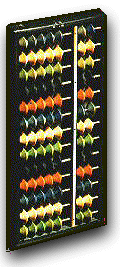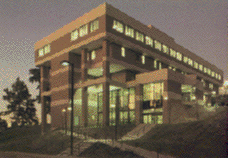BA 103--Computers and Information Systems
List of Concepts
Dr. Bud Banis, 314-516-6136, CCB 230
Off-campus, 636-394-4950 E-mail rbanis@jinx.umsl.edu
System Software
The Disk Operating System (DOS)
What happens when you start up your computer:
-
The processor finds instructions about the specific machine
in ROM and checks that all the basic parts are in place. ROM is nonvolatile
and information can only be changed by changing the chips.
-
CMOS memory is consulted to identify device addresses and
types, such as how much memory, time and date, important information about
secondary storage devices (e.g. the hard drive). Information in CMOS can
be changed, but is maintained by a battery.
-
The boot drive is surveyed to find operating system software
(DOS & BIOS). Resident parts of the operating sytem software are loaded
into memory.
-
CONFIG.SYS and AUTOEXEC.BAT files are executed to install
drivers for devices and define environmental setup factors. These are editable
files on the boot disk.
-
The AUTOEXEC.BAT can be used to define a program(s) run at
startup. For example, many computers are now set up to start WINDOWS right
away
Testing for Viruses
Check your operating manual and virus testing software
to do this correctly.
A good website to visit on this is the Symantec Antivirus
Research Center at http://www.symantec.com
you might also want to check http://www.datafellows.com
for more information and a free copy of their anti-macrovirus software
Terms and concepts you should know:
Computer System = everything, including the people,
involved in processing specific Information or performing a task.
-
Input, Processing, Output, & Storage. = IPOS
-
Hardware, software, firmware (usually ROM).
-
System software, "grass roots" software, programming languages,
application packages
-
Data, programs, utilities, drivers.
-
MIS Directors, Programmers, Operators, End Users are all
part of "the system"
Hardware
-
System unit, devices, peripherals.
-
Support devices=online or offline.
-
System Unit=system (mother)board, processor, memory chips,
slots, boards & ports
-
Places along the BUS Route: processors, memory, expansion
slots, ports, and boards.
-
CPU = Registers, CPU = Arithmetic Logic Unit (ALU) and Control
Unit.
-
Intel CPU chips 8086, 8088, 80286, 80386, 80486, pentium
-
Machine cycle synchronized by system clock. Hz=cycles per
second. speed in MegaHertz (MHz) typical values: 233, 666, 2.24 GHz (Gigaherz)
Storage and transfer of information
-
Serial vs. parallel transmission. width of the bus like lanes
in highway: 8, 16, 32, 64 bit
-
Primary (internal, memory) storage, secondary (external)
storage.
-
Memory: Primary storage for programs and data during processing.
RAM, ROM, CMOS
-
Memory (RAM) capacities such as 640K, 16 Meg, 24, 64,128,256,512...
Megabytes of RAM
-
Machine-readable media: hard disks, floppy disks, tape, Optical
disks.
-
Memory = primary (internal) storage of data and programs
-
Registers in CPU for temporary storage: Instruction, Address,
Storage, Accumulator.
-
Computer does everything in machine language=binary code
instructions. bits are on or off
-
00000000 to 11111111 represents 256 states (0 to 255 decimal)
in 8 bits = a byte
-
One byte is enough to represent a character, such as a letter,
number, etc. in ASCII
-
One Kilobyte = 1024 bytes, (640K is 655,360 bytes) one megabyte
= 1024 kilobytes
-
Database>File>Record>Field>Character=byte>bit
-
(order of size) Bits bytes words kilobytes megabytes gigabytes
terabytes
-
Machine uses binary code=bits. Relate to 2-tick odometer
for conversions to decimal.
High bit low bit
-
Hexadecimal (base 16) notation used by Assembly Language
programmers. Relate to 16-tick odometer. 00 to FF represents 256 states
(0 to 255 decimal) in two characters
-
"Normal" People use decimal & character codes= ASCII
& EBCDIC (7 or 8 bit)
-
Error checking and parity bit set to give even number on,
odd number on or none
-
Milliseconds, microseconds, nanoseconds, picoseconds, femtoseconds
Media:
-
Direct (Random) Access via addresses in the FAT vs. Sequential
Access--tape
-
floppy disks: 8.5", 5.25", 3.5" Single-sided, Double-sided,
& High density (SS, DS, HD)
-
ZIP drive is a 100MB floppy, cost about $100, $10 per disk,
becoming standard
-
Hard disks & Bernouli drives--generally slower than memory,
faster than floppy & optical.
-
Hard Drive capacities usually Gigabytes (GB) Gigabytes (Gigs,
or GB). e.g. 30 GB, 60 GB; some typical older machines have Megabytes,
such as 40, 230, 540, 850 MB. Since newer operating systems (Win95) are
now more than 100 Meg, old machines don't make it anymore.
-
CD-ROM & WORM, Magneto-Optical (M-O); Rewritable optical
platters & Jukeboxes.
-
typical CD-ROM is 650 MB
-
CD-R and CD-RW, DVD-ROM, DVD recordable (several types)
-
All this is changing rapidly as Optical becomes faster, cheaper
and rewritable
Formats:
-
Formatting disks sets up File Allocation Table (FAT), Sectors
& tracks (sides).
-
Hard drives have multiple disks (sides)--gives cylinders
made up of corresponding tracks
-
Partitioning Harddrive-makes one physical device look like
more than one (logical) device.
-
Root Directory & Subdirectories. Like branches on a tree,
or filedrawers.
-
DOS file names and types of files-- *.BAT, *.EXE, *.COM,
*.TXT, *.DBF, *.TMP, *.WK1, Readme.doc.
-
Wild cards * (asterisk) ?
-
Autoexec.bat and Config.Sys are used on startup to configure
the computer.
Hard drive Maintenance:
-
Backup for CMOS startup data="Rescue Disk" (e.g.Norton Utilities)
-
Chkdsk /f or Scandisk in DOS 6.x to fix lost allocation chains,
check disk surface.
-
Temporary files (*.TMP) can accumulate when applications
terminate abnormally. clean them out.
-
"Brush your teeth, wash behind your ears, and defrag your
harddrive".
Input:
-
Devices convert people-style information to machine usable
formats.
-
Keyboards--characters & function keys.
-
Mice, trackballs, light pens & touch screens, digitizing
pads, joysticks, yokes & pedals.
-
Source Data Automation--barcode scanners, magnetic strip
scanners, MICR (Magnetic Ink Character Recognition), optical image scanners
(hand-held, flatbed), Optical Character Recognition (OCR)--e.g. Omnipage,
TypeReader
-
Voice input: IBM VOICETYPE (discreet speech), Dragon NaturallySpeaking
and IBM ViaVoice(continuous) See the MiniMBA
pages for info and links on these. Good Speech recognition software now
costs less than $150, but requires relatively heavy-duty machines (>233
MHz, >48 Meg RAM)
Output:
-
Devices convert machine code to hardcopy, softcopy or info
to other machines
-
Display devices--Video--VDT, CRT, LCD--pixels and bit-mapped
images.
-
Video standards: Monochrome, CGA, EGA, VGA, s-VGA, XGA
-
Teletypes, printers & plotters
-
Impact--daisy wheel, ball, dot matrix: 9-pin and 24-pin ("letter-quality")
-
Non-impact--thermal transfer, inkjet, laser. 300dpi vs. 600
(or more) dpi.
-
High speed line printers and page printers.
-
Color printers--inkjets most common. laser printers becoming
more economical and common
-
Voice output e.g. Arkenstone in Library scans books--> speech
output
-
Speech Recognition, IBM ViaVoice and Dragon Naturally Speaking

E-mail: srjbani@umslvma.umsl.edu
Campus office CCB 230
On-campus phone X6136
Off-campus 636-394-4950
 Return
to Bud's Page
Return
to Bud's Page
You are person number  to access this page since May 25,1998
to access this page since May 25,1998
 Go to UM-St. Louis Home Page
Go to UM-St. Louis Home Page
 Go to UM-St. Louis School of Business Page
Go to UM-St. Louis School of Business Page
last modified August 18,2002 ~~ comments and suggestions to
rbanis@jinx.umsl.edu


 Return
to Bud's Page
Return
to Bud's Page
![]() Go to UM-St. Louis School of Business Page
Go to UM-St. Louis School of Business Page